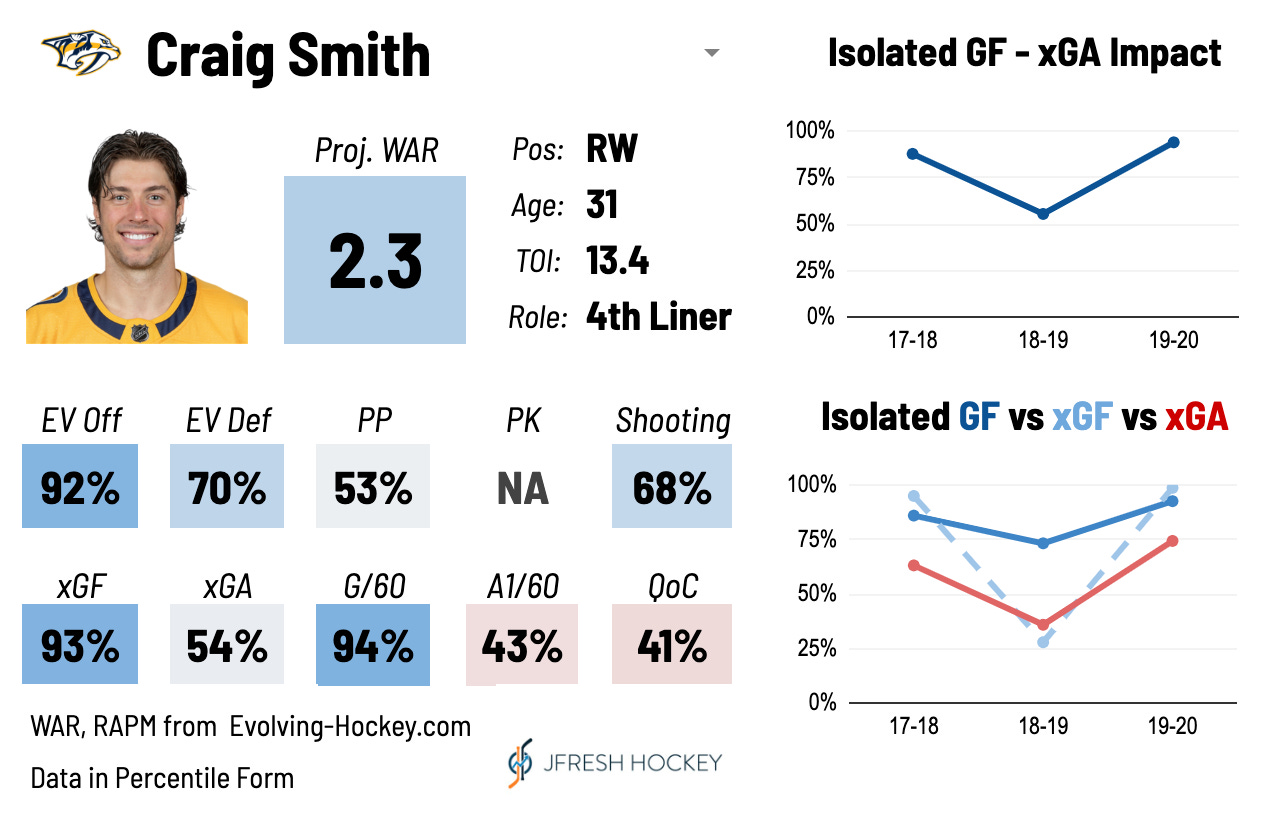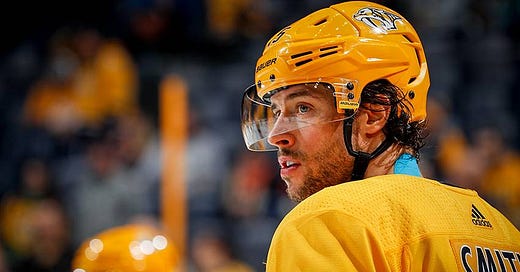What Makes Craig Smith an Analytical Favourite?
The playdriving forward is more than just a boring name

Admiration of Craig Smith has long been a shibboleth for analytically-minded hockey fans. Despite scoring over 50 points only twice in his NHL career, Smith’s sparkling underlying numbers have garnered him admiration dating back to 2016, and with the creation of metrics like Wins Above Replacement and isolate heat maps his impact on the game has only become more celebrated. It certainly doesn’t hurt that he scored at a 20 goal pace in six of the past seven seasons. Not bad for a guy who’s been stuck in bottom-six minutes for most of his career.
Now that Smith is an unrestricted free agent, it would appear that he’s the prime candidate for “Moneyball acquisition of the offseason.” EvolvingWild project a three-year contract at roughly $4.2M, which would be a massive discount for what he brings to the table from an analytical perspective. With this in mind, I thought it would be worthwhile to dig into his numbers and figure out what makes him so effective.
Craig Smith’s Analytical Profile

Craig Smith is a top-end driver of goals, scoring chances, and shot attempts, one of the most efficient goal scorers in the league, and an above-average defensive player as well. His Wins Above Replacement (WAR) is incredibly high, especially considering how few minutes he plays - this season his 0.14 WAR/60 ranked 11th in the league, tied with David Pastrnak and only barely below Nathan MacKinnon. In the past three seasons combined, his 6.8 WAR ranks 28th among forwards, in front of players like John Tavares and Mathew Barzal.
How Does Smith Drive Play So Well?
It’s one thing to recognize Smith’s results, but it’s also important to figure out the process that makes it happen. To do that, we can use a number of methods including traditional stats, microstats, and the good old fashioned eye test.
So how does Smith drive play? By shooting the puck. A lot. Over the past three seasons at 5v5 he ranks 15th in shots and 30th in individual expected goals. Adjusting for ice time, he ranks 3rd in shots per 60 minutes and 15th in expected goals per 60. In this time he also finished 15th in rebounds created with 57 (per NaturalStatTrick). This short compilation from a game I watched of his against the Anaheim should give some sense of how much he loves to fire the puck from anywhere:
Using Corey Sznajder’s manually tracked data, it’s possible to see how shot-oriented his offensive play is - the stats below are represented in percentile form, showing where he ranks compared to other forwards:

Despite being an average playmaker, the quantity of shots Smith takes have made him one of the league’s top shot contributors. This could be the reason that the Predators have not trusted him in a larger powerplay role - firing off shot after shot on the man advantage might be a crowd-pleaser, but generally you would prefer someone who can move the puck more effectively. In the past two seasons, he’s improved when it comes to activating his teammates off the rush, but when he’s in the offensive zone he’s not likely to be seen making crisp high-danger passes.
To put a fine point on this, check out these two heat maps from HockeyViz.com showing Craig Smith’s on-ice offence and personal shot map.

When he’s on the ice, the shots come from the right side and the front, and there’s a very good chance that he’s the one taking them.
While Smith himself is not blessed with much finishing talent - according to HockeyViz he’s been a below-average finisher in four of the past six seasons - on-ice scoring hasn’t been an issue for him. The Preds have actually been able to score above expectation over the course of his tenure with the team in the regular season, about 3 goals per 60 minutes compared to 2.7 expected goals. This is reassuring considering that many players with similar analytical profiles (like Tyler Toffoli or Brendan Gallagher) struggle to convert those chances into goals. They’ve also outscored expectation in each of the past five seasons with him on the ice. Intruigingly, the opposite is true in the playoffs: Smith’s on-ice expected goals per 60 drops to 2.1, but his on-ice goals plummet to 1.3. This is probably the product of bad luck, although he does appear to take slightly lower-quality shots in the postseason.
There’s more to his game than just shooting, even if it doesn’t necessarily show up on the microstat charts. His physical tools are strong, he’s a very good skater, and he does the little things right to maintain possession and put himself in good positions. Defensively speaking, Smith doesn’t excel in the microstats I tend to check when a winger has strong defensive numbers; he’s a below-average forechecker, doesn’t recover a lot of pucks, and isn’t particularly active on the breakout either. Based on the way his defensive numbers align with his offensive ones I suspect that his possession play in the offensive zone is the primary driver, but it would take a deeper eye test dive to pick out what he does effectively without the puck.
Conclusion
You might have gotten the impression from the above that Smith is a shameless Corsi-juicer who’s a lot less valuable than the stats suggest. While I do not think that he should be considered one of the league’s truly elite players, as his WAR would indicate, he’s clearly an extremely effective forward whose volume-based approach has been proven to pay off for his team. It’s not easy to get into shooting position as often as Smith does, particularly in front of the net. When without the puck in the offensive zone it’s clear from watching him that he has a knack for finding open spots. You couldn’t find a better value pickup to strengthen your middle six - a strong comparable in my mind is Mathieu Perreault when he was in his prime with the Jets from 2016 to 2018.
A major consideration for many teams looking at him will the fact that he’s listed as a centre. I’m sad to say that they should probably look elsewhere if they’re trying to fill a positional need. Smith has not finished higher than 7th in faceoffs taken for the Predators in each of the past seven seasons, and I think it’s for a good reason as his shoot-first tendency makes him a better fit on the wing. He’s proven that he can put up excellent results with almost any centre; in the past three seasons he has elevated every centre he’s played with, including Ryan Johansen, Kyle Turris, Nick Bonino, and Colton Sissons. Notably, in that time both Turris and Bonino have elite possession numbers with Smith and terrible ones without him. His fire-from-wherever style might not endear him to top players (I suspect this is why he’s been stuck in the bottom six) and I don’t necessarily see him as a good fit on a team like Montréal or Vegas who struggle with finishing their chances, but a team that struggles to generate scoring chances will likely get excellent value from him.



